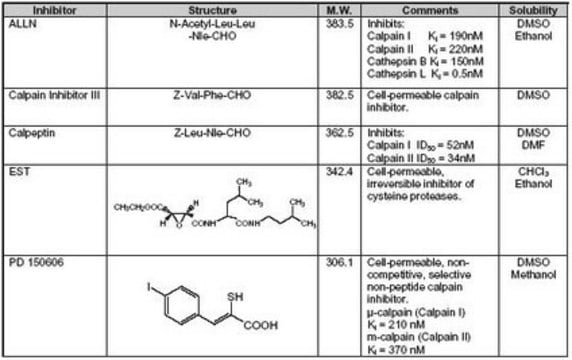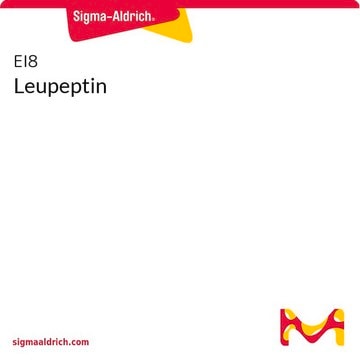330005
EST
A cell-permeable, irreversible inhibitor of cysteine proteases.
Synonym(s):
EST, Loxistatin, (2S,3S)- trans-Epoxysuccinyl-L-leucylamido-3-methylbutane Ethyl Ester, E-64d, Loxistatin, (2S,3S)-trans-Epoxysuccinyl-L-leucylamido-3-methylbutane Ethyl Ester, E-64d
About This Item
Recommended Products
Quality Level
Assay
≥97% (HPLC)
form
solid
manufacturer/tradename
Calbiochem®
storage condition
OK to freeze
color
white
solubility
DMSO: soluble
shipped in
ambient
storage temp.
−20°C
InChI
1S/C17H30N2O5/c1-6-23-17(22)14-13(24-14)16(21)19-12(9-11(4)5)15(20)18-8-7-10(2)3/h10-14H,6-9H2,1-5H3,(H,18,20)(H,19,21)/t12-,13-,14-/m0/s1
InChI key
SRVFFFJZQVENJC-IHRRRGAJSA-N
General description
Biochem/physiol Actions
calpain-1
Warning
Reconstitution
Other Notes
Mehdi, S. 1991. Trends Biochem. Sci. 16, 150.
McGowan, E.B., et al. 1989. Biochem. Biophys. Res. Commun.158, 432.
Tamai, M., et al. 1987. J. Pharmacobiodyn.10, 678.
Komatsu, K., et al. 1986. Exp. Neurol. 91, 23.
Tamai, M., et al. 1986. J. Pharmacobiodyn. 9, 672.
Legal Information
Storage Class Code
11 - Combustible Solids
WGK
WGK 2
Flash Point(F)
Not applicable
Flash Point(C)
Not applicable
Regulatory Listings
Regulatory Listings are mainly provided for chemical products. Only limited information can be provided here for non-chemical products. No entry means none of the components are listed. It is the user’s obligation to ensure the safe and legal use of the product.
JAN Code
330005-MG:
330005-1MG:
Certificates of Analysis (COA)
Search for Certificates of Analysis (COA) by entering the products Lot/Batch Number. Lot and Batch Numbers can be found on a product’s label following the words ‘Lot’ or ‘Batch’.
Already Own This Product?
Find documentation for the products that you have recently purchased in the Document Library.
Customers Also Viewed
Related Content
Select different protease inhibitor types based on your needs to prevent protein degradation during isolation and characterization and safeguard proteins in sample prep.
Our team of scientists has experience in all areas of research including Life Science, Material Science, Chemical Synthesis, Chromatography, Analytical and many others.
Contact Technical Service










